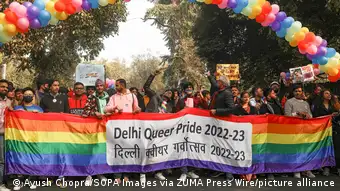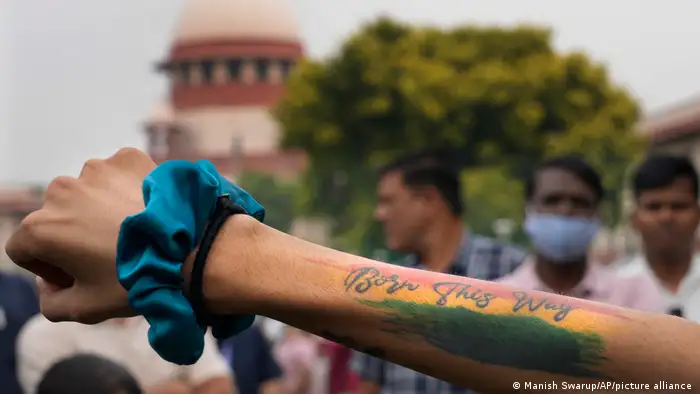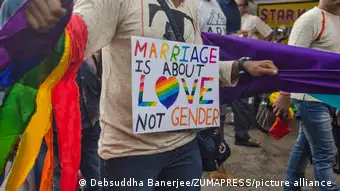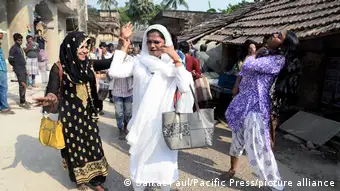Opinion
Northeast India needs better queer news coverage
Queer people get hardly any coverage in local and regional media in Northeast India. News reports are often stereotypical and sensationalist. This needs to change, writes guest author Kaustav Padmapati.
In May 2023, two young women from Guwahati, a city in the Indian state of Assam, got engaged in a personal ceremony. Indian media covered the story of Manisha Rabha (25) and Eliza Wahid (23) and photos went viral on social media, where the lesbian couple was confronted with hate, abuse, and mockery. This is nothing new in media in Northeast India. A number of Assamese news channels and print media from the Northeast still frame queer stories negatively, taking the path of hype and sensationalism, thus creating a negative impact for the queer community.
'Queer sexuality' and 'non-binary identity' are still contested concepts of identity in India. In 2018, the Supreme Court of India struck down the controversial Indian Penal Code Section 377 – a legacy law by former colonial British rulers which had criminalized homosexuality on the subcontinent. In November 2022, two same-sex couples petitioned the Supreme Court seeking legal recognition of same-sex marriages in India. They argued that the non-recognition of same-sex marriage violates the rights to equality, freedom of expression and dignity. The court ruled against legalization in October 2023, albeit pointing out that society has a duty to protect queer people from discrimination.
Although homosexuality has been decriminalized, queer identities appear to be either non-existent or marginalized – especially in the seven northeastern states of India. The region that constitutes eight percent of the country's geographical area and accommodates over 200 ethnic groups has experienced insurgency due to separatist movements and identity conflicts. In three out of seven states, the majority of people practice orthodox Christianity, which still prohibits homosexuality. When it comes to queer movements and awareness, the region is far behind the rest of India. The queer community remained invisible there until early 2000s, due to an absence of strong queer activism and media coverage.
Homophobic content for higher ratings
The media is critical in spreading awareness about LGBTQIA+ rights. However, on 5 June 2021, popular Assamese channel "News Live" aired a news story about a queer couple in a sensational way. The story "Ajab Prem ki Gazab Kahani" (Strange Love's Strange Story) was deemed homophobic and criticized by number of scholars, academicians, and activists from the region. In her Facebook post on June 6, 2021, Dr Bitopi Dutta, academician and gender expert from Assam questioned "why News Live portrayed it as a very sensational weird news." She added "to gain Television Rating Points (TRP) you can always invite us to your studio for various interviews and articles, but when such situation arises where actually your help is needed, you make such a disgusting video?" She requested the news channel to remove the video.
Later, the video was indeed taken down after it had prompted outrage in the queer community and with allies. Mayuri Deka, a prominent queer activist and research scholar from the region, in her Facebook post on 5 June 2021, mentioned that the news had already done more damage than good, jeopardized efforts of the almost decade long queer movement in Assam and harmed not only the targeted couple, but further reinforced the general homophobia that many people have been relentlessly trying to fight against for years. Mayuri urged News Live to air more positive queer news from the region.
Transgender community portrayed negatively
Similarly, lots of negative stories targeting transgender community are also visible in local media, particularly in Assam. The local and regional newspapers and online platforms repeatedly publish stories about alleged attacks on citizens by transgender community and fights between rival hijra groups. Hijras are among the most visible sexual minorities and communities in South Asia that often live on the sidelines, mostly engaged in begging, dancing at family functions, and sex work. Most hijras are born male but prefer to identify themselves either as women or intersex. Despite their significant presence and long tradition in South Asian cultures, they face stigma, abuse, violence and discrimination on a regular basis.
Negative news items really tarnish the image of this community. According to Dr Samhita Barooah, Assistant Professor of Social Work at Tezpur University, Assamese television media "have defamed the [transgender] community as criminal and communal." She further added that these media channels divide the transgender community into three categories of being cheaters, sex racketeers and looters for money. Milin Dutta, founder of Annajori, an NGO focusing on gender and development, said, "I have both positive and negative experience with media. A section of media is supportive about the queer movement; however, sometimes they send people who are not aware about LGBTQ issues. These journalists write stories to increase TRPs of the news. The majority is ignorant."
Gender sensitization of the media is urgently needed

In addition to big cities like New Delhi, pride marches are increasingly being held in smaller towns as well
The queer movement in Northeast India is progressing steadily through the number of queer collectives and non-profit organizations. In 2022 and 2023, pride marches were held in number of small towns of Assam, which hardly got any coverage in local media. This was really disappointing. The transgender community in the region is still struggling to find coverage about their stories and hardships in the media. The time has arrived for all segments of our society to engage in an open and candid conversation about queer rights. Media has always played a crucial role in advocating for queer rights in many liberal democracies around the world. The gender sensitization of media professionals working in the region has become an urgent need for the queer community. Since media plays a crucial role in portraying social narratives and communicating the demands of civil society, media can make a decisive contribution to reducing discrimination against marginalized groups in society as a whole.
Dr Kaustav Padmapati is currently working as Assistant Professor (Senior Scale) at the School of Modern Media, UPES, Dehradun, India. He recently completed a fellowship in Gender and Media Studies at the Institute for Asian and African Studies at Humboldt University Berlin, Germany. He has nearly 12 years of experience in teaching and research, international relations projects, media, public policy, content writing and project coordination.
DW recommends
- Date 23.11.2023
- Author Kaustav Padmapati
- Feedback: Send us your feedback.
- Print Print this page
- Permalink https://p.dw.com/p/4ZIi6
- Date 23.11.2023
- Author Kaustav Padmapati
- Send us your feedback.
- Print Print this page
- Permalink https://p.dw.com/p/4ZIi6



